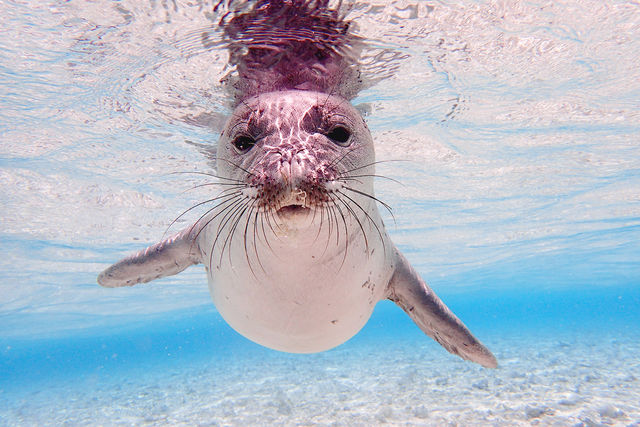PRINCEVILLE — A Hawaiian monk seal thrusts its neck and drops its jaw to reveal a cavernous, pink throat and a sturdy mouth of teeth. “Here, they are doing a little bit of flirting,” Charles Littnan narrates. “It looks a
PRINCEVILLE — A Hawaiian monk seal thrusts its neck and drops its jaw to reveal a cavernous, pink throat and a sturdy mouth of teeth.
“Here, they are doing a little bit of flirting,” Charles Littnan narrates. “It looks a bit different from when we do it.”
The video Littnan is showing portrays a pair of critically endangered Hawaiian monk seals socializing on a secluded Molokai beach. The lead scientist at NOAA’s Hawaiian Monk Seal Research Program, Littnan acknowledges the interaction between the two seals appears aggressive.
But he assures a room of nearly 50 people gathered at Princeville Public Library Wednesday night that the body language the seals are displaying can be likened to good-natured bantering.
Recorded on a tiny camera strapped to a monk seal’s backside, this is the sort of raw, unedited footage that is helping to bridge the gap between what is culturally and historically known about the imperiled monk seal and what scientists are just now learning.
At a presentation and talk story event hosted by the Friends of the North Shore Library at Princeville, Littnan explained how the animal, which is native to Hawaii and whose numbers as slightly rebounding, has had trouble finding its footing in the consciousness of the community.
The monk seal is not memorialized widely, if at all, in traditional Hawaiian chants, songs or hula. Nearly hunted to extinction in the 1800s, the animal was for hundreds of years rarely seen by humans.
That all began to change in the 1980s when the species, which is mainly confined to the uninhabited Northwestern Hawaiian Islands, gradually started recolonizing the main islands. It started with Niihau. Then came Kauai, which now counts a resident population of about 50 animals.
Slowly, the seal has begun to fold itself back into the fabric of the local aquatic community. Yet while many Hawaii residents adore the sweet-faced animal, others question its validity as a native species.
“One of the points of contention is whether or not they are native,” Littnan says. “You have people who live here, 85-year-old fishermen, who have never seen a monk seal in their lives. Then one day they see this giant, fat slug of an animal that’s sleeping there that’s pretty massive. And you know it’s blubber. To get that big you know they have to be eating a lot.”
As such, it has been a struggle to reintegrate the animal back into society, especially the fishing community Littnan says.
Among the misconceptions Littnan says he and other scientists have worked to dispel is the notion that monk seals root around in the coral reef like pigs of the sea, destroying the ecosystem and eating everything in sight. Those who subscribe to this notion, Littnan says, tend to harbor negative feelings toward the seal. Often, they view the animal as competition for the same fish that so many local people catch to feed their families.
This is where the usefulness of the critter cam footage comes into play. By handing over raw video of monk seals as they go about their day, researchers have been able to show residents that the seals are not significant competitors for the local fish supply, nor are they destroying the reef. Rather, they are curious, rambunctious animals who spend two-thirds of their lives at sea, sleeping and hunting for octopus or other bottom-feeders that hide in small pukas in the reef.
As for their appetite, monk seals eat about one pound of fish per square mile of sea, Littnan says.
Following hundreds of years of decline, the species over the last three years has reported a small uptick in numbers. As scientists work to coax a rebound of the monk seal population, educational outreach is crucial to fostering a culture of coexistence between humans and the seals, Littnan says.
All told, 1,400 monk seals live in the wild across the leeward and main islands. Yet whereas 25 years ago a seal sighting in the main islands was incredibly scarce, there are now about 300 of the whiskered animals living from Niihau to Ka Lae, or South Point, on the Big Island.
“We’re not really successful unless a seal makes it to the point where they are now having their own pups,” says Littnan, who says at least 28 percent of the seals that are alive today benefited from life-saving scientific interventions dating as far back as the 1980s. “This is all about getting this species to the next generation, who will then take it to the next generation and the next generation. In order to do that, we have to know how to coexist with both seals and people, and it’s going to be about compromise.”


